
Hanoi is Vietnam's capital and second largest city by population. The city mostly lies on the right bank of the Red River. Hanoi is 1,720 km (1,070 mi) north of Ho Chi Minh City and 105 km (65 mi) west of Haiphong.
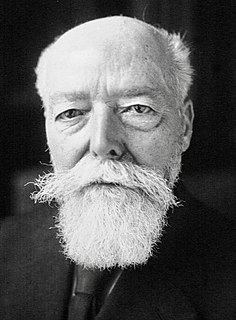
Joseph Athanase Doumerc, commonly known as Paul Doumer, was the President of France from 13 June 1931 until his assassination on 7 May 1932.

The Exposition universelle, internationale et coloniale was a world's fair including a colonial exhibition in the French City of Lyon in 1894. The site was the parc de la Tête d'or in the north of the city. The exposition drew unwanted attention with the assassination of French President Sadi Carnot during his visit on 24 July 1894; he died the day after.
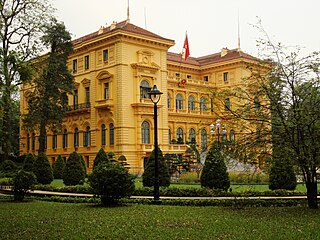
The Presidential Palace of Vietnam, located in the city of Hanoi, was built between 1900 and 1906 to house the French Governor-General of Indochina.
Auguste Henri Vildieu was the French architectural adjutant in Hanoi while that city was an administrative center for the French colony of Indochina. Vildieu constructed several grand European-style buildings for the colonial government, including:

French Colonial describes several styles of architecture used by the French during colonization. Many former French colonies, especially those in Southeast Asia, have previously been reluctant to promote their colonial architecture as an asset for tourism; however, in recent times, the new generation of local authorities has somewhat "embraced" the architecture and advertise it. French Colonial architecture has a long history, beginning in North America in 1604 and being most active in the Western Hemisphere until the 19th century, when the French turned their attention more to Africa, Asia, and the Pacific. Many French colonial buildings are now UNESCO World Heritage Sites.

The Hanoi Opera House, or the Grand Opera House is an opera house in central Hanoi, Vietnam. It was erected by the French colonial administration between 1901 and 1911.

108 Military Central Hospital, also known in many variations as Army Medical Institute 108, or Army Central Hospital 108 is a hospital located at 1 Trần Hưng Đạo Street, in the Hoan Kiem district of Hanoi, Vietnam. It was originally a military hospital for the French army in Indochina built in 1894 known as Lanessan Hospital, and the practice hospital for Indochina Medical College which was located nearby at that time. After the communists took control over Hanoi in 1954, it turned into a central military hospital for senior officials, but now is also open to the general public. It is considered as one of the most famous hospitals in Vietnam. It is the first hospital in Vietnam that carried out organ transplants. It is also famous for surgery.

Ba Đình is an urban district of Hanoi, the capital city of Vietnam. Ba Dinh is the political center of Vietnam. Most of the government offices and embassies are located here. It was formerly called the "French Quarter" because of a high concentration of French-styled villas and government buildings built when Hanoi was the capital of French Indochina. This name is still used in travel literature. The wreckage of a B-52 bomber shot down during the Vietnam War can be seen in Huu Tiep Lake in the Ngoc Ha neighborhood. The Southern half of Hoàn Kiếm district is also called a "French Quarter" also because of a large number of French-styled buildings, most of which are now used as foreign embassies.

Long Biên Bridge is a historic cantilever bridge across the Red River that connects two districts, Hoan Kiem and Long Bien of the city of Hanoi, Vietnam. It was originally called Paul Doumer Bridge.

The Brussels International Exposition of 1935 a Universal exhibition held in Heysel, near Brussels in Belgium, between 27 April and 6 November 1935.

Hanoi railway station is one of the main railway stations on the North–South Railway in Vietnam. It serves the city of Hanoi. The station is located at 120 Lê Duẩn Street, Cua Nam Ward, Hoan Kiem District of Hanoi and is the starting point of five railway lines leading to almost every Vietnamese province.
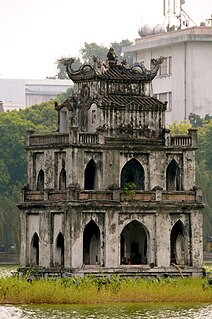
Turtle Tower, also called Tortoise Tower is a small tower in the middle of Sword Lake, Hanoi, Vietnam.
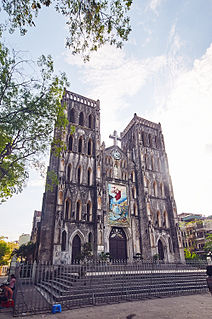
St. Joseph's Cathedral is a church on Nha Chung (Church) Street in the Hoàn Kiếm District of Hanoi, Vietnam. Its a late 19th-century Gothic Revival church that serves as the cathedral of the Roman Catholic Archdiocese of Hanoi to nearly 4 million Catholics in the country. The cathedral was named after Joseph, the patron saint of Vietnam and Indochina.

The Hanoi Metro is a rapid transit system, including elevated and underground sections, serves in and around Hanoi, the capital city of Vietnam, operating by Hanoi Metro Company (HMC). It will be the first rapid transit system of Vietnam.
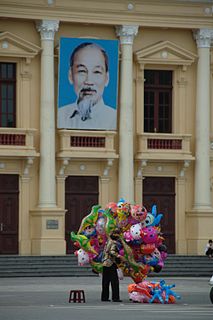
Haiphong Opera House is a French-built neoclassical opera house on Opera Square in Hai Phong, which was opened in 1912.
The following is a timeline of the history of Hanoi, the capital city of Vietnam:

The Hanoi Exhibition was a world's fair held in Hanoi between November 16, 1902 and February 15 or 16, 1903.

The State Guest House is a historical monument in Hoàn Kiếm District, Hanoi, Vietnam. It originally was the residential palace of the Tonkin Governor, built between 1918 and 1919 to house the French Governor of Tonkin. It was later renamed the Tonkin Palace when the Viet Minh took over northern Vietnam. The building is representative of French Colonial architecture in French Indochina.

























